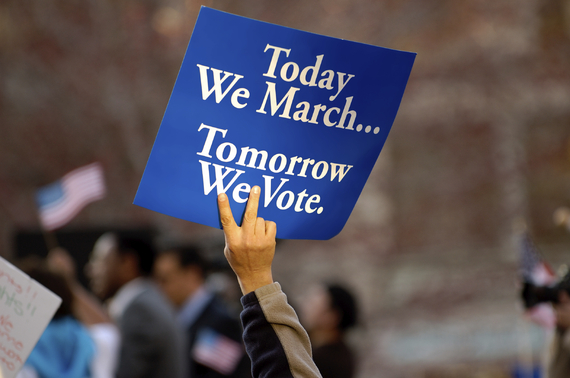In June, Latino organizations banded together to shut down Donald Trump and his cadre of mega industries after his controversial remarks about Mexicans during his presidential announcement speech earlier this summer. First came Univision, then NBC, and since then it seems like a day doesn't go by without us hearing about another Latino celebrity refusing to work with Trump. Within days of his speech, America Ferrera wrote a "thank you" letter to Trump, claiming that his rhetoric would drive Latinos to the polls:
You see, what you just did with your straight talk was send more Latino voters to the polls than several registration rallies combined! ... Remarks like yours will serve brilliantly to energize Latino voters and increase turnout on Election Day against you and any other candidate who runs on a platform of hateful rhetoric.
The fallout from Trump's comments underscores the significant power the Latino population has. Latinos are the fastest-growing major minority population in the U.S. There are now more Latinos than whites in California, and by 2043, Latinos will become the majority-minority. Latinos also control a $1.5 trillion buying power that's already setting trends in tech and media consumption.
Without a doubt, the Latino population has tremendous power. But will our ire at Trump and the ideas he represents be enough to mobilize Latino voters, as America suggests?
Let's consider the patterns of many key Latino social movements in the U.S. If we look at the work of Cesar Chavez and Dolores Huerta during the Delano grape strike and the Los Angeles school walkouts, we observe movements based on boycotts and protests. In all of these mobilizations, Latinos have responded from their positions as an oppressed group seeking to shift the tide by denying the dominant group their participation, labor, and/or resources. Financially pulling out of Trump's industries is of the same vein.
Despite the effectiveness of boycotts and protests, if applied to voting, the same strategy will not be effective. Voting is an activity of investment. It's not a pulling-out, but rather, it is a putting-in. Even while she was protesting and boycotting, Dolores Huerta was signing up voters and lobbying for the issues that impacted Latinos.
As we think now about how to energize and engage Latino voters, we must consider the differences between protesting and participating, and the strengths and limitations of each.
When we vote and invest in campaigns, we use our power differently than when we protest and boycott. Many Latinos are dissatisfied by the political options currently available, and refuse to vote to show their power. Although this frustration is understandable, and we can see where the tactic behind this idea originates, the long-term consequences of Latino political disengagement will be devastating.
Take for example, the recent mayoral loss of Leticia Van De Putte from San Antonio. Van De Putte is a San Antonio native with decades of public service experience. She lost by a margin of 3.4 percent in a city that is 63 percent Hispanic in large part because only 14 percent of voters turned out. In a city with this high of a Latino population, Van De Putte's loss is heartbreaking. For those of us working to elect more Latinas into public office, Van De Putte coming up short has pushed increasing voter turnout to the top of our agendas. Even with qualified, financially backed, and promising candidates, Latinos aren't going to go to the polls, and we want to know why.
I suspect that is because Latinos haven't yet fully bought in to the power of the vote. Among some communities, there's still a strong distrust of politics and our government. For many others, government and the political sphere are not "our systems." However, it's hard to boycott democracy. In order for Latinos to see politics as a space in which they have ownership and agency, they need to be able to see themselves represented in them. This is why our work to make visible leading Latinas and Latinos is so critical. When we see ourselves in the system, we believe that we have a voice, that someone in there gets us, and will advocate for us. We see that buying into the system is worth it. Organizations like the Latino Victory Project that recruit and support top talent from the Latino community believe that there's a strong correlation between increased civic engagement and the increase of Latino leader visibility. We need to have one in order to shift the tide of the other, and vice versa.
We, as Latinos, have a tremendous amount of power at our disposal. The numbers are there, but we need to own and use that power to create the system we want to see. According to Gallup, in the 2012 elections only 51 percent of Latinos eligible to vote had registered. In 2016, rather than conversations about who is courting us for their vote, let's start thinking about who we want to elect, what kind of candidates we want to see, and start investing in them, because the only way that the system will become one that works for us, is if we start working it.
Get involved, donate to a campaign, volunteer, and vote!

